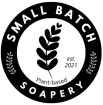Small Batch Soapery uses limited ingredients – no harsh chemicals/detergents. Soaps are made via the cold process soap method (no high heat), utilizing skin-loving plant oils and shea butter. Most soaps have added coconut milk and kaolin clay (pore cleansing, adds a nice feel to the bar) for extra goodness. Soaps are colored using clays or skin-safe mica pigments and fragranced with quality sourced fragrance oils and/or essential oils.
Plant-based oils used – NO animal fat/lard. Vegan friendly.
Olive Oil: This is a staple in cold-process recipes. It’s a thick oil that moisturizes the skin and creates a creamy lather.
Coconut Oil: Coconut oil is super cleansing and produces large bubbles in cold process soaps. Adds hardness to the bar.
Shea Butter: Shea butter is a fat extracted from the nut of the African shea tree. Shea butter feels luxurious and moisturizing on the skin. It helps harden cold-process soap.
Castor Oil: Castor oil is a thick multi-purpose vegetable oil that people have used for thousands of years. It’s made by extracting oil from the seeds of the Ricinus communis (Castor Bean) plant. It draws moisture to the skin and creates an amazing lather in soap.
Sunflower Oil: This oil is rich in essential fatty acids and vitamin E. It produces a lather that is incredibly conditioning on the skin. Only high-oleic sunflower oil is used here at Small Batch Soapery.
Hemp Seed Oil: Hemp oil is wonderful on the skin as it is very hydrating and won’t clog pores (its fatty acid profile mimics that of our skin) and has anti-inflammatory properties that may help soothe redness and itchiness, as well as help to reduce swelling. Hemp oil in soap creates an excellent lather. This oil is sometimes used here at Small Batch Soapery, primarily in facial soaps.
Other Soap Additives:
Micas: Micas are a powder colorant that usually contains a slight to intense shimmer. In geology, mica refers to a group of metamorphic minerals. Micas come in many different forms due to the wide array of ways in which they can form within the earth. Whether micas are “all-natural” is debatable, as some have added colorants – also, the term “natural” is unregulated and often up for interpretation. The micas used by Small Batch Soapery are all skin-safe and cruelty-free.
Coconut Milk: Coconut milk has high levels of Vitamin C which helps maintain the elasticity and flexibility of the skin. It is also rich in medium-chain fatty acids which help to smooth the skin cells and lock in moisture. Coconut milk adds a luxurious texture to soap. Read more, here.
Fragrance: Added by using a Fragrance Oil blend, or with pure Essential Oils to add scent to the soap. Usage guidelines are followed for safe skin application (IRFA guideline recommendations are followed). Fragrances are sourced from reputable vendors.
Sodium Lactate: Sodium lactate is a liquid salt that hardens cold-process soap so it can be unmolded more quickly, lending firmness to the bars. It’s derived from the fermentation of sugars found in corn and beets.
Titanium Dioxide: Also called titania, (TiO2), a white, opaque, naturally occurring mineral used for coloring soap.
Kaolin Clay: A cosmetic clay rich in silica and with a neutral PH. It’s a mild clay and can be used safely on all skin types. Kaolin clay is a very effective skin cleanser, helping to slough away dead skin cells and absorbing impurities from the pores.
French Clay: French Green Clay is considered by many as a healing clay widely used for its skin healing properties. When applied to the skin, it essentially absorbs toxins and poisons that get trapped in the skin. The clay originates from France and is mined directly from the earth.
Brazillian Clay: Found in different regions of Brazil, it helps to absorb excess oils from the skin.
Aloe Vera Juice: This is added to some soap in place of distilled water. The polyphenols, along with several other compounds in aloe vera, help inhibit the growth of certain bacteria that can cause infections in humans. Aloe vera is known for its antibacterial, antiviral, and antiseptic properties. This is part of why it may help heal wounds and treat skin problems.
Sodium Hydroxide Lye: Sodium hydroxide, also known as lye and caustic soda, is an inorganic compound with the formula NaOH. It is a white solid ionic compound consisting of sodium cations Na⁺ and hydroxide anions OH⁻ . Sodium Hydroxide Lye creates a chemical reaction known as saponification. This process is what breaks down the oils and turns them into soap. The finished soap is free of lye, only the saponified oils remain (it is a necessary component of soap making).

